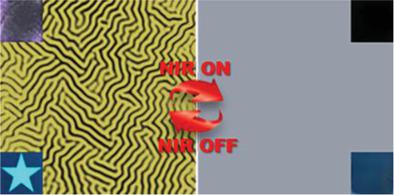Our official English website, www.x-mol.net, welcomes your
feedback! (Note: you will need to create a separate account there.)
Photodynamic Pattern Memory Surfaces with Responsive Wrinkled and Fluorescent Patterns
Advanced Science ( IF 14.3 ) Pub Date : 2020-10-14 , DOI: 10.1002/advs.202002372 Shuai Chen 1 , Tianjiao Ma 1 , Jing Bai 1 , Xiaodong Ma 1 , Jie Yin 1 , Xuesong Jiang 1
Advanced Science ( IF 14.3 ) Pub Date : 2020-10-14 , DOI: 10.1002/advs.202002372 Shuai Chen 1 , Tianjiao Ma 1 , Jing Bai 1 , Xiaodong Ma 1 , Jie Yin 1 , Xuesong Jiang 1
Affiliation

|
Reversible pattern systems, namely pattern memory surfaces, possessing tunable morphology play an important role in the development of smart materials; however, the construction of these surfaces is still extensively challenging because of complicated methodologies or chemical reactions. Herein, a functionalized basement is strategically integrated with a multi‐responsive supramolecular network based on hydrogen bonding between aggregation‐induced emission luminogens (AIEgens) and copolymers containing amidogen (poly(St‐co‐Dm) to establish a bilayer system for near‐infrared (NIR)‐driven memory dual‐pattern, where both the fluorescence emission and wrinkled structures can be concurrently regulated by a noninvasive NIR input. The motion of the AIEgens and photo‐to‐thermal expansion of the modified base allow temporal erasing of the fluorescent wrinkling patterns. Meanwhile, when exposed to 365 nm UV radiation, the fluorescent patterns can be independently regulated through photocyclization. The fluorescent wrinkling pattern presented herein is successfully demonstrated to promote the level of information security and capacity. This strategy provides a brand‐new approach for the development of smart memory interfaces.
中文翻译:

具有响应性皱纹和荧光图案的光动力图案记忆表面
可逆图案系统,即图案记忆表面,具有可调的形态,在智能材料的发展中发挥着重要作用;然而,由于复杂的方法或化学反应,这些表面的构造仍然具有很大的挑战性。在此,功能化基底与基于聚集诱导发射发光体(AIEgens)和含有氨基的共聚物(聚(St- co -Dm)之间的氢键的多响应超分子网络战略性地集成,以建立近红外双层系统(NIR)驱动的记忆双模式,其中荧光发射和皱纹结构都可以通过非侵入性 NIR 输入同时调节。AIEgens 的运动和修饰碱基的光热膨胀允许暂时擦除荧光同时,当暴露于365 nm紫外辐射时,荧光图案可以通过光环化进行独立调控。本文提出的荧光皱纹图案被成功证明可以促进信息安全和容量的水平。该策略提供了一种全新的方法用于开发智能内存接口。
更新日期:2020-11-19
中文翻译:

具有响应性皱纹和荧光图案的光动力图案记忆表面
可逆图案系统,即图案记忆表面,具有可调的形态,在智能材料的发展中发挥着重要作用;然而,由于复杂的方法或化学反应,这些表面的构造仍然具有很大的挑战性。在此,功能化基底与基于聚集诱导发射发光体(AIEgens)和含有氨基的共聚物(聚(St- co -Dm)之间的氢键的多响应超分子网络战略性地集成,以建立近红外双层系统(NIR)驱动的记忆双模式,其中荧光发射和皱纹结构都可以通过非侵入性 NIR 输入同时调节。AIEgens 的运动和修饰碱基的光热膨胀允许暂时擦除荧光同时,当暴露于365 nm紫外辐射时,荧光图案可以通过光环化进行独立调控。本文提出的荧光皱纹图案被成功证明可以促进信息安全和容量的水平。该策略提供了一种全新的方法用于开发智能内存接口。











































 京公网安备 11010802027423号
京公网安备 11010802027423号